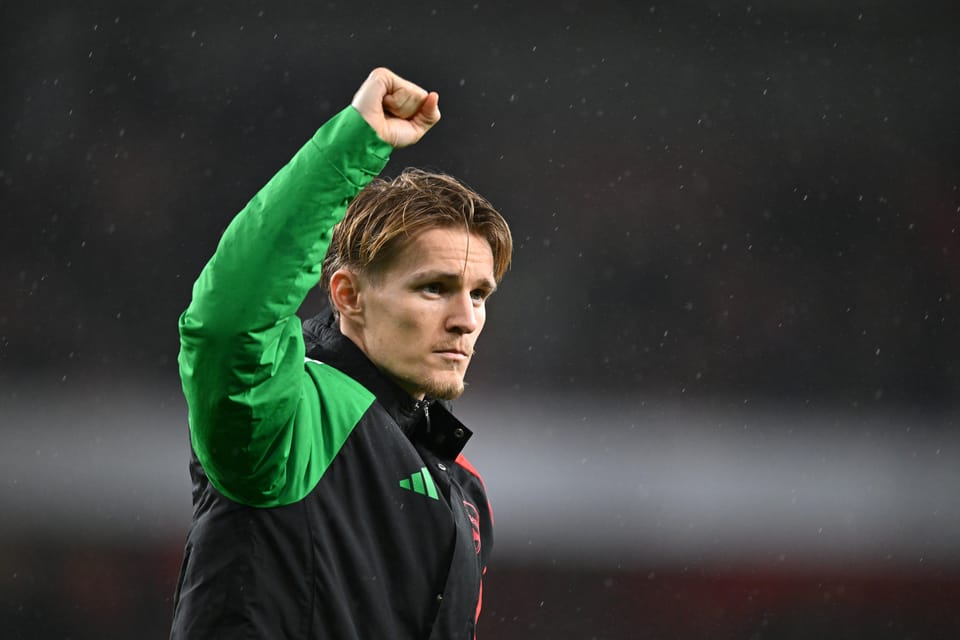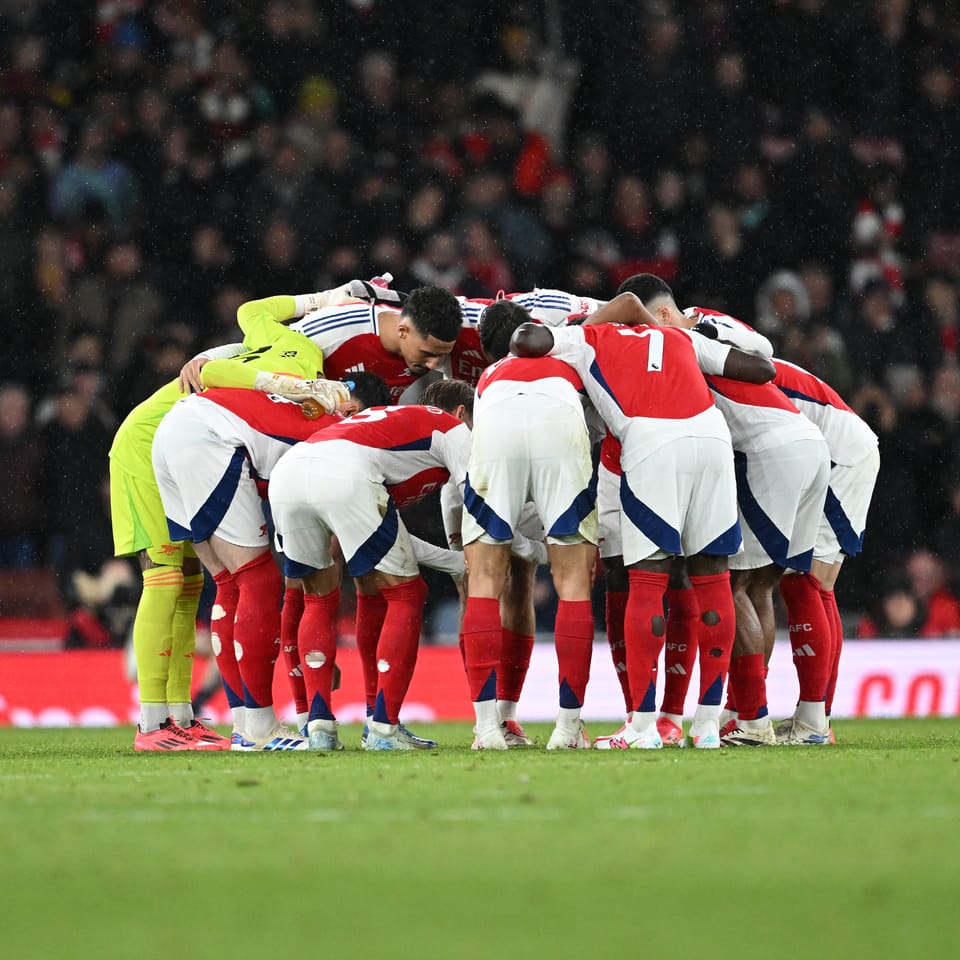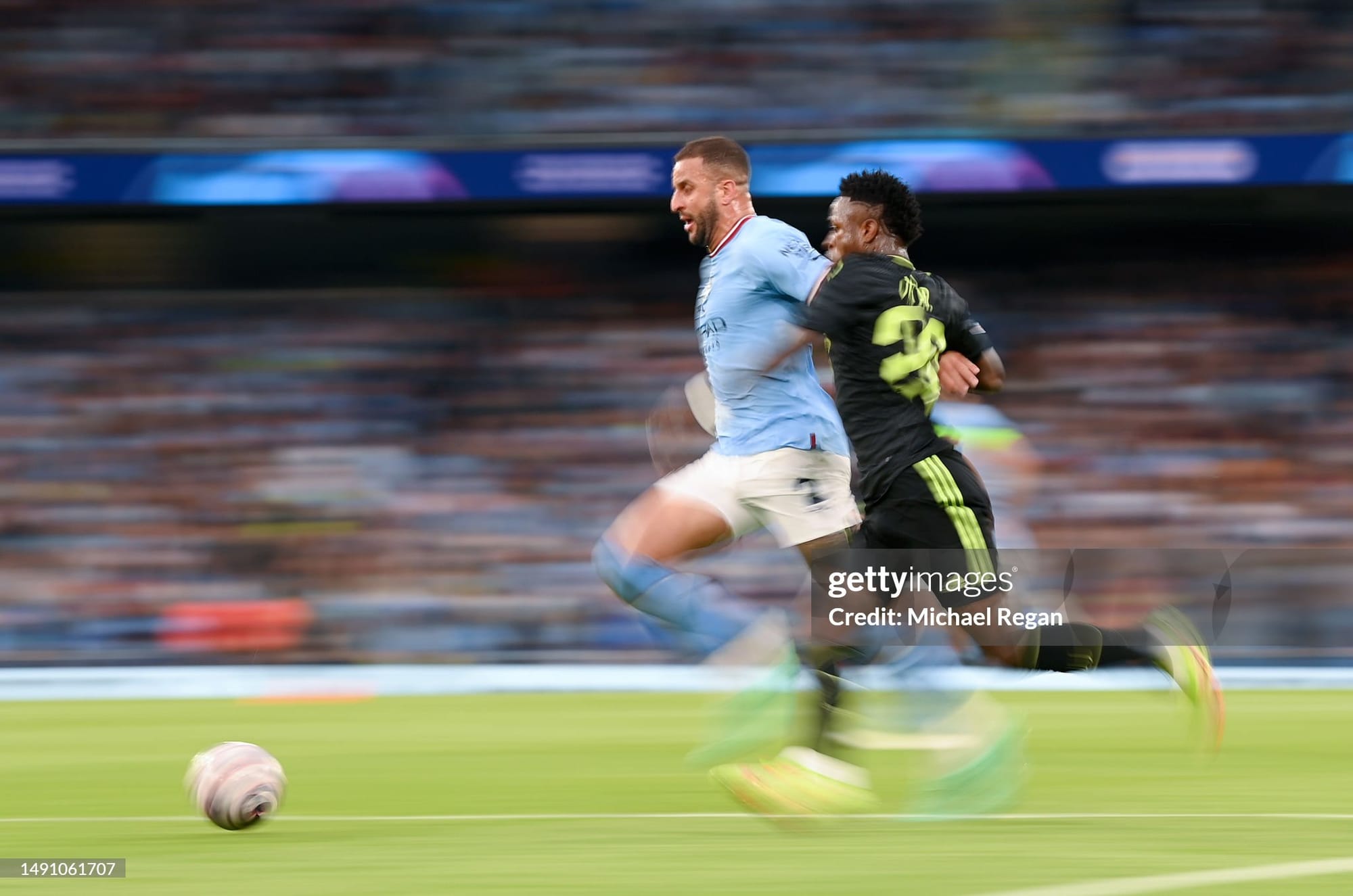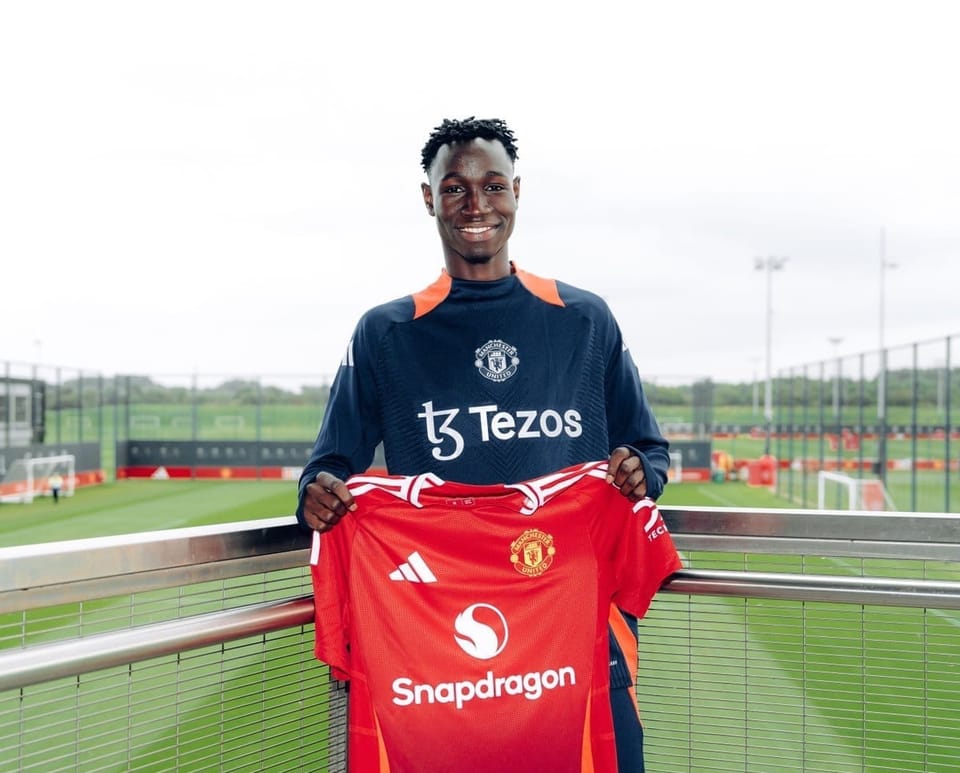Developing A Framework to Assess and Fine-Tune Dribbling in Football
Culmination of a year-long immersion into football.

This article is the culmination of my year-long independent immersion into football. There's some data, some philosophising, some analysis, little narrative, some Manchester United, some mechanics chatter, some scouting paradigms, some inferences about player development, some talk about football's meta. There's essentially something for everyone. I hope you leave here with something. Feel free to pause, take notes, and punt questions, corrections, or challenges at me once you're done.
See you at the end!
0. Interlude
You’ve watched players masterfully tease, caress, and synergise with the ball – each one in their own distinct manner, in different situations, and with varying efficiency. But what underlies this art of dribbling? How does it manifest in the game? Can we train it? How does it differentiate across players? How do we hone it?
Key definitions for this article:
- Dribbling: staying on the ball while moving it around the pitch
- Carrying the ball: synonymous to 'dribbling'
- Take-on: getting past a challenging opponent while dribbling the ball
- Beating a man: synonymous to 'take-on'
- Progressive carry: dribbles that move the ball a certain distance or percentage closer to goal
1. Introduction
Picture this: a winger, ball at their feet, sizing up the defender. The defender is trained to spring into action when the attacker accelerates or nears the goal area. Skilled dribblers, aware of this, often manipulate their pace to deceive and outmanoeuvre their opponents.
'Go slow to go far'
In football, defenders are trained to intervene whenever an attacker seems to be an immediate threat:
- When they are about to enter the box
- When they accelerate
So we find that, amongst other features, players who consistently carry the ball far (or rack up high progressive carries) are necessarily adept at slowing down or lowering their dribbling tempo to lull the opposition into a false sense of security.
'Go fast to beat short'
Now, unlike the previous phrase which I use as a coaching phrase, this one is more conceptual.
On the other end of the spectrum, the act of beating a player entails that an attacker bait and escape a defender's challenge. This is also how the stats websites collect this stat.
Therefore, the players who consistently complete dribbles are necessarily adept at momentarily accelerating or leveraging a higher dribbling tempo to commit and beat the opposition.
Case-Study 1: Alejandro Garnacho
One player who might help us assess this distinction in action is Manchester United's Alejandro Garnacho.
The young Argentine has stolen the hearts of United fans – especially match-goers – with his dynamism, directness, and deft touches. Amongst other things, these are symptoms of a fanbase which have, in recent years, been starved of flair and aggressiveness down the flanks. If you frequent United's matches, in the pub or game-centre, you can smell the anticipation and butt-raising feeling whenever Garnacho receives the ball out wide and charges.
Erik ten Hag on Alejandro Garnacho: “He has a lot to learn still. He has capabilities what fans like, but what is more important, he contributes to compact opponents. He can outplay defending lines with a lot of skills and that's what I like.” [MUTV]
What does the manager mean by 'compact opponents,' and why has he situated this above 'what fans like,' which is take-ons and dynamism? To understand this and clarify our initial points about 'Go slow to go far' and 'Go fast to beat short,' let us start by examining one instance of Garnacho's dribbling.
Feel free to watch and make your own inferences before proceeding.

Now, here's a walkthrough of the situation:
- Garnacho receives the ball to feet, without pressure, with space (and one man) ahead of him, and brings it down in the direction of his marker. It is a signal of a duel, similar to how a gunslinger stances and rests their hand on their holster in a face off.
- He maintains a relatively consistent pace across the initial phases of the dribble: soft touches, feints, no dynamic pushes.
- As such, as we described earlier, the perceived threat in the defender's mind are minimal, so they'll naturally retreat to their box. Go slow to go far.
- Once he's carried the ball into the box, Garnacho then tries to take on his man outside with a quick burst. Go fast to beat short.
- Unfortunately, the winger doesn't have the acceleration to escape his man or balance to win the shoulder-to-shoulder duel.
- Feedforward: Assertive carrying. Forces or, as Erik says, compacting the opponent into their box. Weak in the take-on. This combination personifies Garnacho's dribbling package.
The data might help us extrapolate our analysis.
A cursory look at Alejandro's dribbling profile (via FBref) across the last year highlights this disparity. The Madrid-raised forward is in the 99th percentile for Carries into Penalty Area, 93rd percentile for Progressive Carries, 79th percentile for Carries into Final Third, and similarly ranked for Total and Progressive Carrying Distance.
He is categorically top at bringing the ball up the field: great at Going slow to go far.

However, he is in the 5th percentile for both Successful Take-On Percentage, Times Tackled During Take-On. Compared to his peers at this level, he is weak in this department. Yet, Garnacho attempts 5.71 take-ons per 90 (in the 85th percentile), which suggests a misalignment in the Argentine's capacity to beat a man.
Nevertheless, we have here a player who is strong at carrying the ball up the field (slow to go far) and weak at taking on players (far to beat short).
Herein lies the scope of this article:
- How do we distinguish between capacity to capacity to carry the ball forward vs capacity to take on a player vs dribble out of pressure?
- What are the phases of any dribble?
- What is the relationship between a player's physical capacity and their technical execution in the dribble?
- How can we derive actionable (scouting, coaching, or opposition analysis) solutions to a player's dribbling?
- What is temperament and how does it facilitate or weaken a player's capacity to dribble?
What are the distinctions between a take-on and carry?
In the following sections of this essay, we will further develop our initial framework to address the previously mentioned questions. Then, we will present targeted solutions to address the challenges faced by Alejandro Garnacho.
3. Frameworks for Dribbling
Phases of a Dribble
In football, the tactical flow and rigid spatial dimensions of the pitch allow us to segment a dribble into distinct phases. Understanding these phases helps in analyzing a player’s dribbling technique and decision-making. Here’s a breakdown of these phases as I interpret them:
- Preparation Phase: This is about the initial conditions under which a player prepares to recieve the ball. It includes various scenarios like receiving the ball while moving or stationary, into open space or directly to feet, under pressure from opponents or in open areas, and whether the player is oriented towards the goal or has their back to it. Each scenario demands different skills and decisions.
- Reception Phase: In this phase, the focus is on the player's first touch and posture. Key aspects include the angle and direction of the initial touch, whether the ball is kept close (static touch) or pushed forward (directional touch), and how the ball is controlled when the player is in motion. The quality of this touch sets the stage for the subsequent attack.
- Attack Phase: Here, the player with the ball decides how to navigate the defending opposition. This involves choices like cutting inside towards the goal or moving outside towards the flank, being reactive (responding to defenders' movements) or proactive (dictating the play), sticking to a predetermined move or adapting dynamically, and choosing between shorter, more controlled strides and longer, more aggressive ones. This phase is crucial in determining the effectiveness of the dribble or could be take-on itself.
We will now use another case-study to delineate each step.
Case-study 2: Arjen Robben
Here is the full frame of Robben's dribble and shot sequence vs Barcelona:

- Preparation Phase: When Robben receives a ball into open space, he's already considering his next move. With his marker in the box and the backline retreating, he assesses the defenders' positions and the gaps they leave. This phase is crucial as it involves strategic planning — understanding where defenders are moving and building momentum for the next action. Robben's awareness of the backline converging towards him presents opportunities to exploit their momentum by driving against their direction.
For evidence of how momentum influences defenders during the Preparation Phase, see the following video featuring Oleksandr Zinchenko.
The internet mocked Zinchenko over the past couple days for his comments here, but any defender will agree that warding off attackers who’ve garnered momentum (into the box) is very difficult.
— Joel A. A. (@joeladejola) December 26, 2023
Both: “[Imagine if] he gets pace against me…”pic.twitter.com/nEpfJAmBWA
It's strikingly similar to the Robben situation, isn't it? Although these instances are several years apart, the underlying principles — the 'micros' and models of execution in football — remain remarkably consistent. This is testament to the enduring nature of certain aspects in the game and why we need to study the past to unravel tomorrow.
- Reception Phase: Robben's initial control is crucial. He cushions the ball with his chest, seamlessly transitioning it into his stride. By the end of this phase, his upright posture is both deceptive and strategic, giving him the flexibility to launch an attack in either direction and keep the defender guessing.
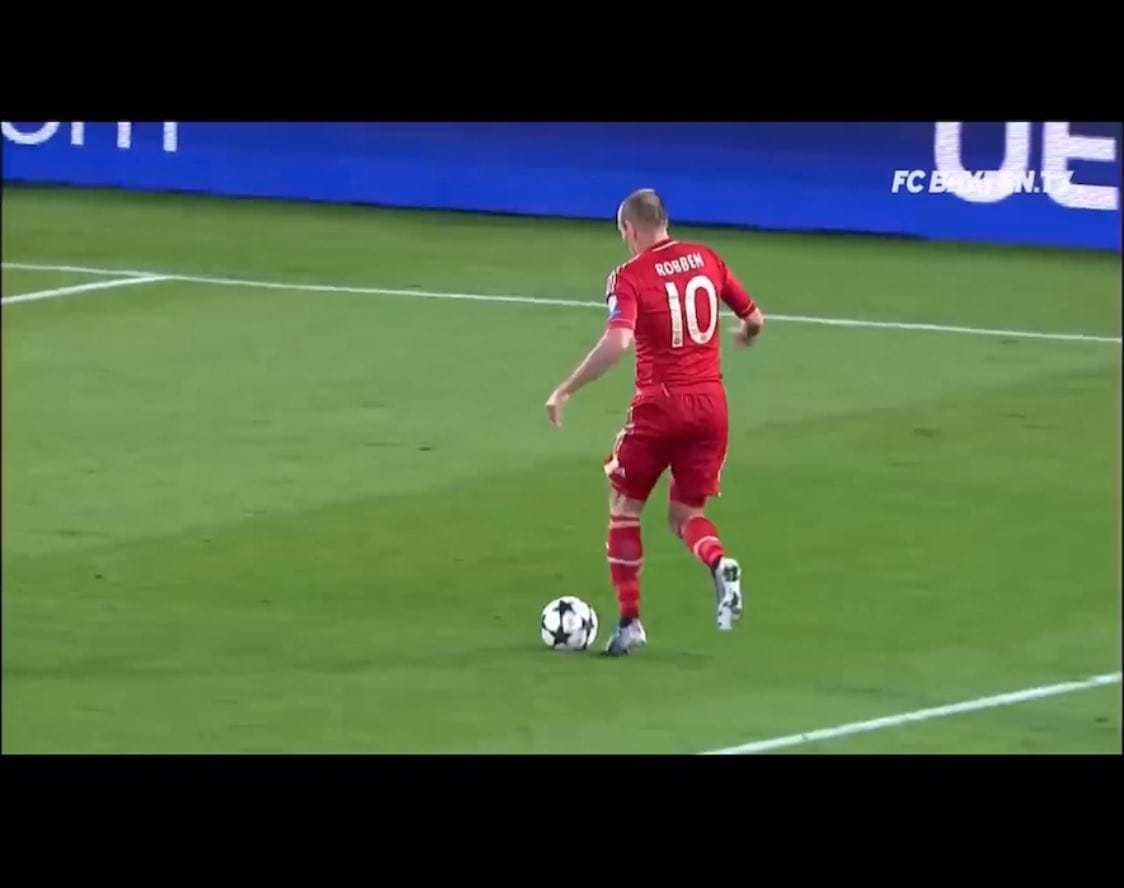
- Attack Phase: Within a fraction of a second, as the opposing player decelerates to engage, Robben powerfully steps off his right foot, initiating his take-on. He opts for a signature move — cutting inside for a shot. This decision-making process, executed in mere moments, exemplifies the essence of the Attack Phase, where agility, technique, and tactical acumen converge.
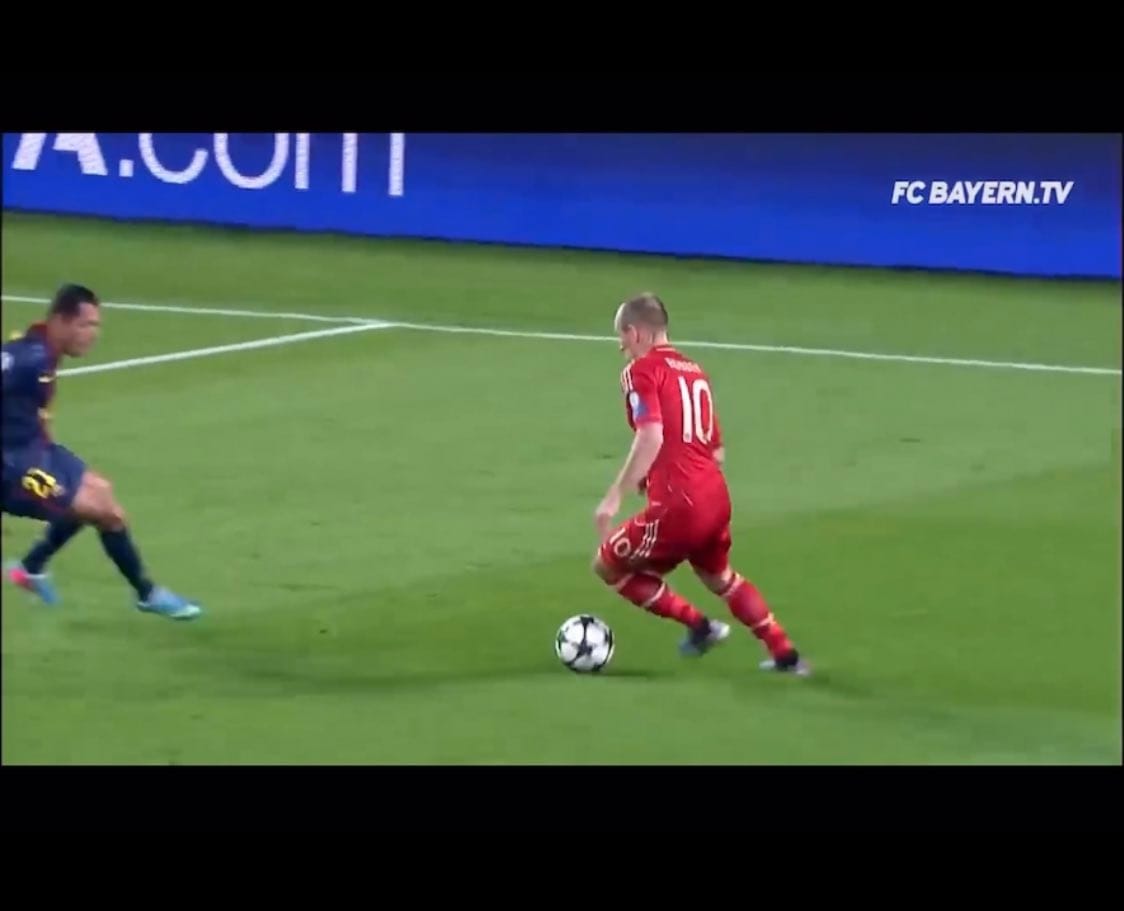
As seen in our two case-studies so far, dribbling is an dynamic negotiation between:
- The ball carrier
- The defender(s)
- The space between (1) and (2)
- The speed of the ball carrier
- The distance to the opposition goal
Generally, we find these elements of space and time, and their importance, to be consistent across other micro-features in the sport. We will unravel each in subsequent posts.
Another framework to consider when coaching dribbling comes from the English FA, via England Football Learning:
When helping players to dribble, try to factor in each of the four corners. Here are some areas to consider.
Psychological: the perception of pressure and space when scanning the pitch.
Physical: the change of pace and direction to exploit space.
Social: the ability to combine with a teammate to move or 'lend' the ball.
Technical and tactical: the skill to control the ball – whether close or far.
Our fifth corner: Integration
I propose a fifth corner to the FA's synopsis of dribbling: Integration. This aspect emphasizes the importance of players finding comfort in their abilities and continuously refining their skills to achieve an equilibrium between what they can physically execute and their technical prowess – techno-physical capacity. It focuses on a player's self-awareness, helping them understand their unique strengths and limitations, and how to adapt their dribbling style accordingly.
As coaches and analysts, our role is twofold. On one hand, we encounter some players who innately grasp which approaches and mechanics suit their athletic capacities – they just know. On the other hand, there are those who require our collaborative effort to discover and refine the techniques that best harness their unique strengths and address their weaknesses. In both scenarios, our task is to support these players, either by validating their self-awareness or by actively helping them navigate and optimize their abilities.

Crucially, the decision to focus on leveraging a player's strengths versus improving their weaknesses hinges on several key factors. These include the player's current stage of development, the level of competition they are facing, and the potential benefits versus risks of making changes to their style or skills. Each of these elements plays a vital role in determining how much and in what ways we should adjust our development approach, aiming to optimize both the player's individual growth and their efficacy within the team.
On an October '23 episode of the Tifo Football Podcast, performance manager Callum Walsh says this about fine-tuning:
“Biomechanics is really important, but we need to be careful. One thing is if it's not broke, don't fix it. If you have a Luis Suarez or Mohammed Salah who pay every minute of every game … and they are not missing any games, don't try and fix it. Because these players are so finely tuned [to perform at this level] where if you try and fix it, you can actually create a lot more problems. Because they've found this level of homeostasis where their body is set: that is the norm for them, and they can play at that level.”
Compare this to a younger player who's still honing their craft and has less game-to-game demands on their body and technique. In these formative stages, careful and strategic adjustments can be instrumental in shaping a more robust, versatile player. This process, nuanced and gradual, respects the individual's current abilities while guiding them towards a broader range of skills and resilience necessary for the higher demands of professional play.
Let's now dive into a broader evaluation of this fifth corner and how it manifests in dribbling and other micros in the sport.
4. Techno-Physical – what the heck is that?
In any sport, we probe an athlete's physical range (athleticism and body proportions) because it determines what range of motions are feasible. A tall and strong player will contest. A flexible player will weave. When we intersect these with a player's perception-action facilities, we arrive at a smaller sample of consistently executable actions. I've found this to be the fundamental of scouting in any sport. It is what I mean by techno-physical. It is also considerably easier to type.
I've pulled a random assortment of parameters from a template scouting report to emphasise why such analyses matter:
- Running Gait and Dribbling: The way a player runs - their gait - has a directly impacts their dribbling style. It influences not just if they dribble, but how effectively they maneuver the ball while in motion. Dribbling is running + ball.

- Balance and Dueling: A player's balance is crucial in one-on-one duels. It determines not only their ability to engage in these battles but also how well they can maintain control under pressure.
- Balance and Evasive Maneuvers: Good balance is essential for players who frequently perform evasive maneuvers, such as quick turns and changes in direction. This is particularly important for midfielders and attackers who need to navigate through tight defensive setups.
- Agility, Flexibility, and Creating Space: These attributes are key in determining a player's ability to create separation from defenders, particularly when looking to take a shot. The ease with which a player can generate this space is often a product of their agility and flexibility.
- Vertical Leap, Balance, and Strength in Aerial Duels: The combination of vertical jumping ability, balance, and strength dictates a player's effectiveness in aerial challenges. This blend of attributes determines not just how successfully they do so but if a player contests in the air.
- Leg Proportions and Tackling: The physical proportions of a player, especially their legs, affect their tackling ability. This includes the space they need to execute a tackle and the ease with which they can perform it.
- Core, Arm Strength and Defensive Positioning: Central defenders benefit significantly from physical strength. It aids in winning aerial duels, holding off attackers, and maintaining positional integrity during physical challenges.
It's important to recognize that regardless of a player's technical prowess in controlled environments like small 3v3 games, there is a separate athletic baseline that is crucial for consistent and top-level performance in the full 11v11 format.
Hence, why we posit a 'range of effectiveness' not just an absolute values (1 or 0) when factoring in their physical attributes:
- Consider a strong, unshakable carrier who excels in short 20-yard bursts but struggles over longer distances due to average top-end speed and stamina.
- In case-study 1, we saw Garnacho struggled over shorter burst, but we will soon see that across longer distances, his pace brims.
In football, technical skills such as passing, shooting, and dribbling are inextricably linked to a player's physical makeup. Ultimately, it is essential to remember that football players are, first and foremost, athletes whose physical capabilities lay the groundwork for their technical skills.
5. Finetuning and Temperament
Fine-tuning a player's skills and identifying areas for improvement begin with an acute awareness of their own physical capabilities. To aid this process, I often recommend that athletes study and emulate professional players who not only excel in certain skills but also share a similar physical build or functional base. This approach is more realistic and practical than trying to mimic players whose physical attributes significantly differ.
For instance, Bruno Fernandes, despite his technical prowess, cannot emulate the mechanics of Jamal Musiala in terms of driving forward and committing opponents due to differing physical bases. It's about streamlining or sieving the skills that are practicable within the confines of one's own body and abilities. This is where self-awareness becomes critical. The best players understand their physical limits and adapt their game mechanics accordingly. If a player is relatively slower off the mark, attempting to dribble like Gareth Bale circa 2010 is likely to be ineffective.
This understanding and acknowledgment of one's physical capacity is not just self-awareness; it's also a reflection of temperament.
Football writer Lorcan Reese aptly stitches these elements together in a recent comment.
The "if they [insert action here]" aspect of a player's game is inevitably influenced by their temperament. This opens up discussions about how temperament is shaped by biomechanics and a keen awareness of one's limitations.
In an earlier piece, Lorcan discusses how Arsenal Captain Martin Ødegaard's has compensated his one-footedness and inadequacies when shielding the ball by floating, finding very specific pockets to operate in, and adjusting his stride length when arriving onto the ball.
Simply, a player's temperament can either facilitate or hinder their techno-physical capacity in certain situations.
Consider these:
- A player who is a poor dueller cannot afford to be aggressive or go stride-for-stride when stepping unto quicker opponents. Arsenal's Jorghino discusses this specific alteration in a recent conversation on the Athletic Podcast.
- Cristiano Ronaldo's struggles in his return to Manchester United can partly be attributed to a delay in adapting his style to his evolving physical capacities. Although his touch became looser and flexibility decreased, he continued attempting manoeuvres and initiatives more suited to his younger self.
- Aaron Wan-Bissaka's tackle and duel heavy approach to defending means he is susceptible to knocks, heavy falls, and the occasional trampled. Yet, he remains reliable and assured in his duels due to his calm, unfazed temperament.
These examples highlight the importance of understanding and appreciating one's current physical abilities. The sports most consistent and longevity players are constantly fine-tuning their mechanics to suit their evolving capacities. By doing so, they can adapt their techniques and strategies to maximize their effectiveness on the pitch, ensuring that their playstyle aligns with their physical strengths and limitations.
6. Scouting Paradigms - Why Does Any of This Matter?
Before we proceed with the final case studies, let's reconcile why these deliberations are important. Across my scouting immersion over the past 18 months, I've found there to be two primary, yet co-dependent, methodologies employed to evaluate and project a player's ability and fit:
1. The Constructive Approach – optimist
This method focuses on identifying a player's strengths and how they can be maximized within a team context:
- Scouting the Player: This initial step involves a thorough assessment of the player's skills, attributes, and potential.
- Proposing an Ideal Role: Based on the scouting insights, a suitable role for the player is proposed, considering where their abilities would be most beneficial.
- Deducing Preferred Angles and Situations: Further analysis is conducted to understand the player's preferred playing styles, angles, and situations within their ideal role, revealing how they naturally approach the game.
- Envisioning the Player Within a Squad: The final step involves imagining how the player might fit into a specific team setup. This includes considering how they could influence team tactics and how well they would integrate with the existing dynamics of the squad.
2. The Subtractive Approach – pragmatist
This approach is curated for development coaches and focuses on identifying and addressing a player’s limitations:
- Scouting the Player: Similar to the constructive approach, this begins with an in-depth evaluation of the player's current abilities and areas of improvement.
- Flagging Roles of Difficulty: Identifying roles or positions where the player currently struggles, which helps in focusing development efforts.
- Spotlighting Challenging Mechanics, Angles, and Situations: This involves a detailed look at specific mechanics, angles, or game situations the player finds challenging – especially ones that might be necessary in the targeted game-model.
- Charting a Development Pathway: Based on these insights, a mock-up development plan is created, targeting specific areas for improvement to enhance the player’s overall game and adaptability. This essentially becomes a feasibility study:
- Given our current status, do we have enough time and coaching investment to bring this athlete to par?
- Is there evidence of the athlete's commitment to improvement?
NB: The points (about roles) emphasized in italics within each scouting approach are dependent on the athlete's stage of development. Positional fit or specific role responsibilities are less critical when evaluating younger, pre-professional players—such as those in K-12—compared to scouting players who have already entered the professional ranks.
Here is my comment from October '23 which delineates the use-case of either approach:
The first one is glamorous: use it to convince someone (the director or fans) of a player’s ability.
— Joel A. A. (@joeladejola) October 20, 2023
The second is practicable: use it to discover and convey opportunities for improvement. For coaches to fine-tune talent.
Now, let's revisit some of the case-studies from earlier to posit improvements in the player's dribbling mechanics. We will frame our recommendations off the role they fulfil in their team, and for the player's overall development.
Feed-forward for Case-Study 1: Alejandro Garnacho
In revisiting our case study (1) of Alejandro Garnacho, we identified his proficiency in carrying the ball over long distances. However, the data and video analysis reveal a notable discrepancy in his 1v1 engagements. While he demonstrates a robust set of 1v1 mechanics, they seem to be misaligned with his techno-physical capacity, particularly when faced with the athleticism of Premier League fullbacks.
Here's a concise outline of his typical behavior in isolation plays around the box:
- During the Reception Phase, he usually idles the ball, as his way of indicating duelling intent.
- He looks for the overlap or underlap runs from teammates as a cue to initiate his attack on the alternative side. He attempts most take-ons on the outside and typically escaped the contest when coming inside.
- His strategy includes pronounced step-overs and feints in an attempt to lure the defender into a misstep. These typically end up with him in less control as defenders are not certain they can match him either way.
- In the Attack Phase, he commits to one side with a forceful push, in an attempt to exploit the defender's momentary imbalance.
Although there's a richness to his approach, Garnacho's burst is not quite at the level of most Premier League fullbacks. This deficit in stand-still acceleration diminishes the effectiveness of his otherwise elaborate isolation mechanics. At the moment, his mechanics and approach in the take-on resemble one (in his prime) Cristiano Ronaldo, without the techno-physical capacity to match.
Recommendations for Alejandro Garnacho:
- Refined Feinting Mechanics: Minimize excessive shoulder-tilting and full-body feints. A more upright posture can help maintain balance and tighten the control circle, making his movements more efficient and less predictable.
- Leverage Underlaps and Overlaps.
- Momentum in Transition: Avoid coming to a complete stop in when it's time to set the opponent for the one-on-one. Entering the attack phase with built-up momentum can compensate for inadequate stand-still burst and can better position him to exploit available passes or runs.
- Calculated Dribbling: Be more conservative with take-on attempts. Reduce risk by choosing the double-team moments to challenge defenders one-on-one.
- Physical Conditioning: Engage in specific gym routines focused on core strengthening, alongside plyometric exercises to enhance explosiveness. This will support better balance during dribbles and quicker acceleration from a standstill.
Case-study 3: Kaoru Mitoma
Let's now consider another player who I think possesses a similar functional base, albeit at a higher tier, to the Madrid-born forward. Brighton's Kaoru Mitoma.
Does anyone see any sort of similarity between Mitoma and Garnacho?
— Joel A. A. (@joeladejola) April 26, 2023
In my initial observations around April, I found that, in addition to their slender build, height, and proportions, both players possessed similar mechanics in the longer carries: slow to go far. The accents they both blessed the ball with were strikingly similar: soft touches, little acceleration to slowly but eventually push the opponent to their 18-yard box.
Here is one instance:

Generally, bar Michael Owen's gracious TV spiels about finishing techniques, football players are rarely engaged about their mechanics during post or pre-match interviews. So you must imagine how fortunate and gracious it is that Mitoma took time to detail his dribbling approach with Japanese media.
【#三笘薫 選手の“ドリブル”を徹底解剖】
— 報道ステーション+土日ステ (@hst_tvasahi) June 21, 2023
世界最高峰の舞台でも脚光を浴びている
三笘選手のドリブルは“なぜ抜けるのか?”
突破のカギは
①「ボールの置き所」
②「静止とインステップ」
→#内田篤人 さん(@AUchidaOfficial) がピッチ上で三笘選手とマッチアップ!
▼詳しくは動画でチェック⚽️ pic.twitter.com/rEM7a1ZXXe
I previously remarked that players are more comfortable and liberal during local interviews (especially during international breaks). They are goldmines for any scout or coach or learner looking for another perspective on an athlete.
In the video, the Brighton winger delves into his dribbling mechanism and offers demonstrations! His approach highlights the importance of spatial awareness, deception, and physical execution in effective dribbling. Comparing Mitoma's own comments to our earlier deductions can shed light on how individual attributes shape a player’s dribbling style:
- Spatial Awareness and Deception: Mitoma talks about how in the preparation phase, he checks the space ahead and misleads opponents by glancing at other areas. This tactic not only prepares him for potential movements but also keeps defenders guessing about his next action.
- Controlling Defender Movements: He also says that he momentarily stops or lowers his tempo to disrupt the opponent’s rhythm – tempo dribbling. This pause can cause defenders to hesitate, allowing the dribbler to regain the initiative.
- Physical Execution of the Dribble: Mitoma’s says he prefers to start dribbles with the instep, rather than the inside of the foot, is a technical choice influenced by the desire for agility and speed. This approach, inspired by Neymar, prioritizes a swift and fluid transition into a dribble, mirroring a sprinter’s start. This is one major difference in the execution between Garnacho and Mitoma in one-vs-ones; it's a learning opportunity for the Argentine.
About the reason for starting dribbling with instep not inside of the foot. When dribbling with the inside, hip joint is twisted and agility at start of dribbling is lack. The trick is to start with instep like running race. And he acquired this skill by imitating Neymar.
— Yatao (@yataoda4) June 22, 2023
(3/3) pic.twitter.com/5KbbjyPuea
- Learning from the Best: The fact that Mitoma developed this skill by imitating Neymar underscores the importance of learning actionable from established players – especially those with similar or recreate-able functional bases to yours.
It is evident how multifaceted the nature of dribbling. It encompasses not just the physical execution but also the cognitive elements of deception, rhythm manipulation, and spatial exploitation.
Earlier, I've suggested that both Mitoma and Garnacho possess a similar functional (athletic) base, employ similar techniques to carry the ball. Is there any indicator in the data?
The short answer is yes: similar prowess in (progressive) carries; relative weakness in take-ons; the former though is more secure on the ball with significantly less miscontrols and dispossessions per 90.

7. Final Words
There's a discernible trend towards players with exceptional dribbling skills, particularly in midfield and wide areas. This shift is evident in the recruitment strategies of many top-tier teams, who are increasingly seeking players capable of breaking lines, creating space, and unsettling defenses through their dribbling prowess.
By acknowledging and adapting to this shift in the meta, scouts and coaches can better prepare players for the demands of modern football. The ability to identify and develop skilled dribblers will be a key differentiator in building competitive and dynamic teams capable of executing tomorrow's football strategies.
With some intentionality, we can play a small part if shaping and identifying tomorrow's...
What Next?
If you enjoyed this, consider subscribing to BallerzBantz, following us on Twitter, and sharing this with someone. We're publishing one bite-sized analysis + solution daily. By subscribing, you will receive one synopsis each week.
Join us to stay ahead and contribute to this burgeoning community.
Who is the Writer?
Joel A. Adejola is an undergraduate at the University of Kansas (KU), studying Engineering and Philosophy.
